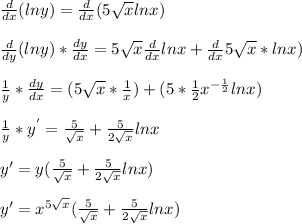
Mathematics, 29.02.2020 02:03 zaanebali
Differentiate y = x5√x. SOLUTION Since both the base and the exponent are variable, we use logarithmic differentiation: ln y = ln x5√x = 5 x ln(x) y' y = 5 x · + (ln(x)) · y' = y + 5 ln(x) = x5√x . Another method is to write x5√x = eln(x) 5√x : d dx x5√x = d dx = d dx 5 x ln(x) = x5√x .

Answers: 3


Another question on Mathematics


Mathematics, 21.06.2019 23:00
Is a square always, sometimes, or never a parallelogram
Answers: 2

Mathematics, 22.06.2019 00:30
Kevin has a spinner that has 10 equal sections and 2 sections of each color—red, blue, green, yellow, and purple. kevin spins the spinner 180 times. kevin determines about how many times the spinner will land on red or green, and his work is shown below. -kevin has the formula reversed; it should be the total number of sections over the number of red or green sections. -kevin should have used a 4 in the numerator because there are 2 red sections and 2 green sections. -kevin should multiply by the number of sections in the spinner rather than the total number of spins. -kevin calculated the prediction correctly and did not make any mistakes.
Answers: 1

Mathematics, 22.06.2019 03:00
In this problem, we explore the effect on the standard deviation of multiplying each data value in a data set by the same constant. consider the data set 14, 6, 8, 15, 15. (a) use the defining formula, the computation formula, or a calculator to compute s. (round your answer to one decimal place.) s = 4.28 (b) multiply each data value by 3 to obtain the new data set 42, 18, 24, 45, 45. compute s. (round your answer to one decimal place.) s = 12.83 (c) compare the results of parts (a) and (b). in general, how does the standard deviation change if each data value is multiplied by a constant c? multiplying each data value by the same constant c results in the standard deviation remaining the same. multiplying each data value by the same constant c results in the standard deviation being |c| times as large. multiplying each data value by the same constant c results in the standard deviation increasing by c units. multiplying each data value by the same constant c results in the standard deviation being |c| times smaller. (d) you recorded the weekly distances you bicycled in miles and computed the standard deviation to be s = 3.8 miles. your friend wants to know the standard deviation in kilometers. do you need to redo all the calculations? yes no given 1 mile ≠1.6 kilometers, what is the standard deviation in kilometers? (enter your answer to two decimal places.)
Answers: 1
You know the right answer?
Differentiate y = x5√x. SOLUTION Since both the base and the exponent are variable, we use logarithm...
Questions



Biology, 23.11.2019 02:31




Biology, 23.11.2019 02:31



















